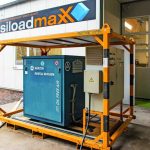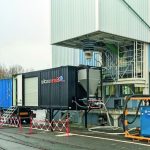On short-distance transport routes in particular, silo trucks are a tried and tested means of moving dusts, powders and granulates onto the road – and hence into the logistics chain. For longer journeys, the silo is no longer lying on a trailer behind a tractor but is integrated into the frame of a maritime container on board a cargo ship. The disadvantage of such proprietary container/silo solutions, however, is that they have to be returned to the plant empty once unloaded. Siloadmaxx has developed a pneumatic method for loading silo materials into ISO containers in a dust-tight condition. It relies on blower technology from Aerzen.
Standard maritime containers are the cheapest means of transportation in the world. Containers are generally hired from the shipping companies and, once unloaded at the receiving port, are simply returned. A pressure vessel, on the other hand, always belongs to someone or other. While the outer transport packaging – the standard container – simply remains at the destination port, a pressure vessel delivered full to China must be returned to the sender. This efficiency loss in the logistics chain, with correspondingly high costs, lay behind the decision to rethink silo technology and integrate it into the maritime container in a highly effective manner. Siloadmaxx is a new concept developed by the company of the same name.
Perfect freight protection
The aim of developing Siloadmaxx was to be able to utilise the loading volume of 20, 30 and 40-foot containers right up to the roof – without big bags, special boxes or bags on pallets that are difficult to fill. The engineers hit on the idea of using a so-called liner bag inside the standard container. “I compare the tear-resistant PE bag with a second skin. It clings to the container wall during loading, thus protecting the freight from contamination and humidity”, explains Christian Hanses, Managing Director of Siloadmaxx.
A telescopic loading lance then blows the product into this space, which is hermetically sealed against the container wall. “To do this, we need just under half an hour for a 20-foot container or one hour for 40-footer and high-cube types”, Hanses reports. The Delta Blower packages from Aerzen have a delivery rate of up to 1000 m3/h and transport the material dispensed by a rotary feeder into the container at a speed of up to 35 m/s.
Blower integrated in the control system
“Air is a very important topic for us, as we are loading under pressure. We introduce bulk material into a wafer-thin bag. However, the material will destroy the bag similar to sand blasting if it does not lie close up to the wall. We therefore start building up the material flow in the centre of the container in order not to damage the walls”, Hanses continues. The position of the telescoping filling unit is controlled fully automatically. The level of automation is such that the units developed by Siloadmaxx can be integrated into the central local merchandise management system and a PLC controls the rotary valves of the connected silo plants independently. The procedure works so effectively that the loading volume can be utilised almost completely to just below the roof.
Due to the different materials with varying densities, chemical properties and specific weights, a blowing technology that can also be precisely adapted to the correct volume and pressure via the PLC of the loading unit is required for standard containers. Siloadmaxx uses Aerzen blower packages such as the BVO 100 from the Rental Division (GM 25 S), which can be mounted decentrally. These ready-to-connect positive displacement blowers deliver flows of between 624 and 1452 m3/h at differential pressures from 50 to 1000 mbar. Thanks to the frequency converters, the mobile units can be controlled exactly – an important criterion when different types of materials have to be introduced into the container safely and quickly.
Among the typical products are cement, soot, silica sand and plastic intermediates such as polyvinyl butyral (PVB) – a substance used, for example, as a hot melt adhesive in the form of intermediate films for laminated safety glass. Given the tough quality requirements in the automotive industry, this material must be completely free of impurities. Since PVB is also employed as a binding agent in adhesives and coatings or as a copolymer and adhesive additive in mortars and concretes, this gives an idea of the quantities which have to be transported around the world. The same applies to bisphenol (BPA), a globally traded starting material for polymer synthesis.
Effective explosion protection
Aside from the purely pneumatic aspects, Siloadmaxx’s decision to go for Aerzen blowing technology was also swayed by the spark arresters integrated into the design of the Delta Blower series. This feature is extremely important for safety, because dusts from plastic or pure carbon, such as soot, always have a high explosion potential and consequently an Atex classification. “The liner bags are therefore equipped with electrical arresters that prevent electrostatic discharge due to the friction of the dust particles. That doesn‘t help much, though, if the blower emits sparks through the conductor in case of a malfunction”, Hanses comments. Theoretically, there is a risk of sparking whenever the rotary pistons of the Delta Blower or the rotors of a screw type compressor (Delta Screw) touch, for example during a bearing rupture. The Aerzen sound absorbers, which are designed specifically as (absorption agent-free) resonators, reliably stop and extinguish these sparks. The spark arresters are TÜV certified.
So what happens after loading? Siloadmaxx likewise relies on compressed air and Aerzen blowers for unloading at the customer. The densely compacted product has to be made free-flowing again. Hanses: “You’re probably familiar with this behaviour from flour and cement bags”. His company developed the Container Quick Flow system (CQF) for this purpose. This mobile unit is suspended on the container and re-fluidises the freight with targeted compressed air flows at the bottom.
Prospects for the future
“Our method protects the goods from the container and the container from the goods”, says Christian Hanses. The high degree of transport safety and the sharp drop in cargo losses enable costs to be saved all along the line. Benchmarked with dispatch in big bags, these savings are in the order of several million euros. The transport costs per unit are just ten percent of what they were previously. The Managing Director is pleased to have won leading logistics companies such as the Schmidt group as partners. He sees a successful future for the new loading and unloading technology with blower air from Aerzen. “It’s been win-win for us along the entire logistics chain – we’re convinced that future generations will consider our system the standard.“
Hall 26, Booth E12
www.cpp-net.com search: cpp0217aerzen
Thorsten Sienk
Technical journalist
Share:









